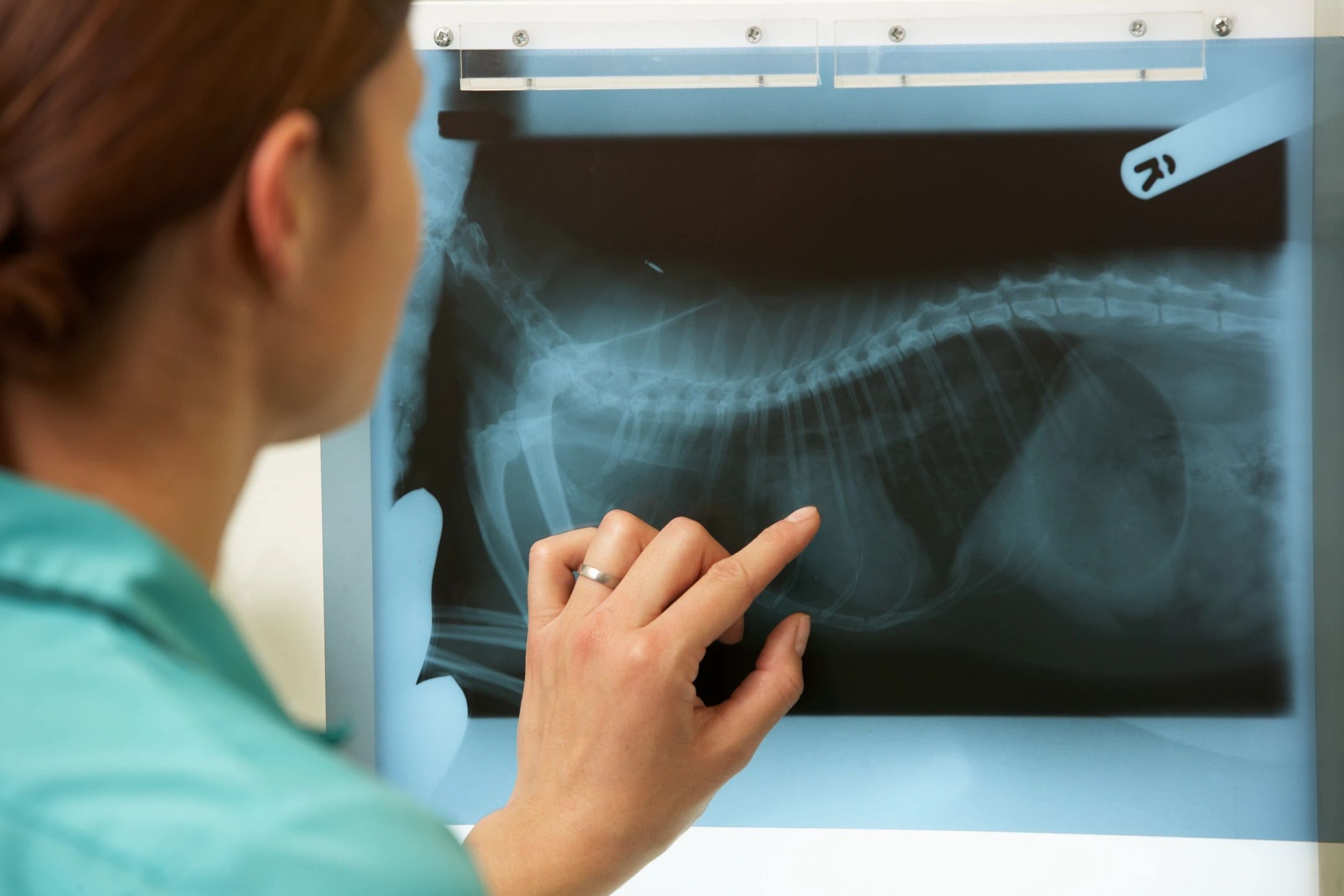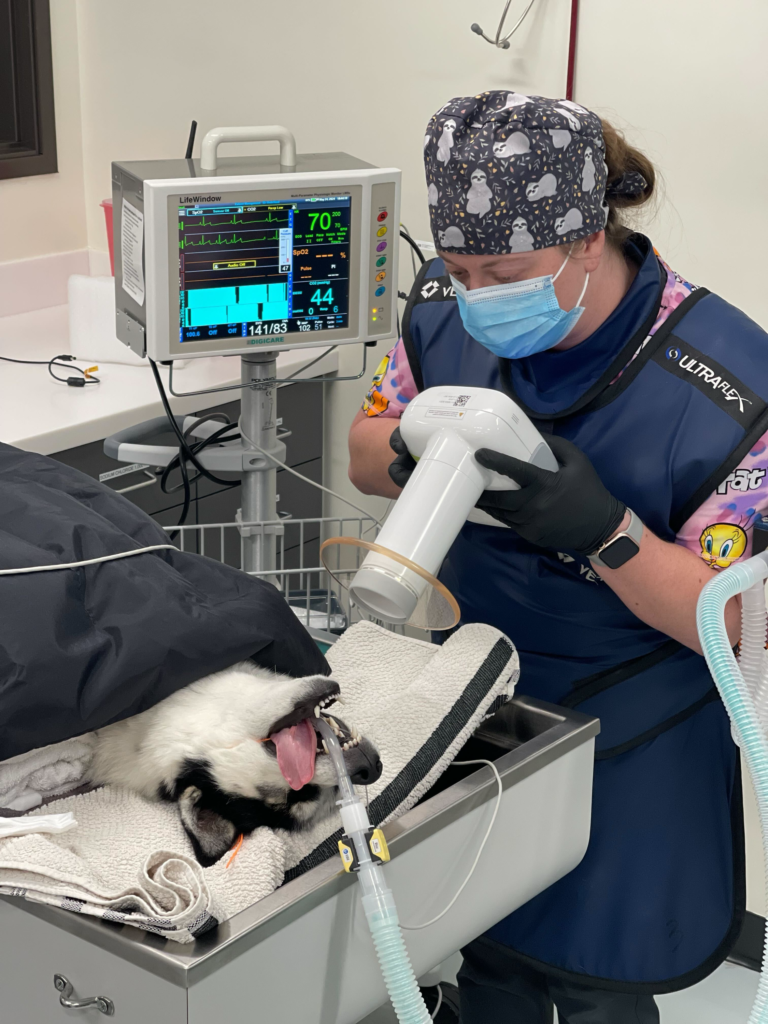
Full Body X-Ray for Pets in Queen Creek, AZ
In Queen Creek, AZ, having access to advanced diagnostic tools, like full body X-rays at your local vet clinic, can be a game-changer for your pet’s health. Revel Vet stands out as one of the few veterinary clinics equipped to offer comprehensive full body X-ray services.
Overview of Digital Full Body X-Ray for Pets in Queen Creek, AZ
Revel Vet is dedicated to providing advanced veterinary care, ensuring that pets in Queen Creek, AZ, receive the highest standard of treatment. Among our variety of modern services, digital full body X-ray stands out as a critical diagnostic tool.
This capability allows for detailed and swift diagnosis of various conditions, from bone fractures and internal injuries to detecting early signs of disease that are not visible externally.
Want to keep your pet in top shape? Explore how our routine physical exams help detect health issues early and support long-term wellness.
Benefits of Digital X-Rays Compared to Traditional X-Rays
Digital X-rays are incredibly helpful to fear-free clinics like Revel Vet. They require less time to perform, significantly reducing stress and anxiety for pets. This faster process minimizes the discomfort and time pets spend under examination.
Digital X-rays offer reduced exposure to radiation and produce higher quality images, enhancing the overall safety and effectiveness of diagnostic procedures. If an initial image is unclear or incomplete, digital technology allows for quick retakes, ensuring that the most accurate information is captured without significant delays. Digital X-rays can be immediately reviewed by both in-house veterinarians and, if necessary, a Board-Certified Veterinary Radiologist, facilitating rapid diagnosis and timely treatment planning.Digital X-rays can be immediately reviewed by both in-house veterinarians and, if necessary, a Board-Certified Veterinary Radiologist, facilitating rapid diagnosis and timely treatment planning.

Digital X-rays can be immediately reviewed by both in-house veterinarians and, if necessary, a Board-Certified Veterinary Radiologist, facilitating rapid diagnosis and timely treatment planning.
How Digital X-Rays Work for Pets Compared to Traditional
Digital X-rays represent a significant advancement in veterinary medicine. Unlike traditional X-rays, digital x-rays utilize electronic sensors to instantly capture images of a pet’s internal structures and store them digitally, providing the vet with immediate access.
The benefits of digital X-rays include not only the speed of obtaining images but also the quality and flexibility of the imaging.
Digital images can be easily enlarged, enhanced, and manipulated to better visualize certain areas, which is less feasible with film X-rays. Enhanced image clarity helps veterinarians make more accurate diagnoses.
Despite these advantages, not every vet clinic has these available. The primary barrier is the cost—digital X-ray equipment involves a significant initial investment. Transitioning to digital X-ray systems often requires significant changes to a clinic’s existing workflow, including staff training on the new technology. This can be a substantial undertaking, especially for smaller or less financially robust practices.
Preparing Your Pet for a Digital Full Body X-Ray
To prepare your pet for a digital full body x-ray, the staff here at Revel Vet may ask you to take a few steps not only to gain clear images, but also to make your pet as comfortable as possible during the procedure.
Fasting may be required for several hours beforehand, especially if sedation or anesthesia will be used, to ensure your pet’s safety during the procedure.
Arriving early can give your pet some time to acclimate to the clinic, reducing anxiety before the X-ray begins. To make your pet more comfortable in a new environment, bringing a favorite blanket or toy can be very helpful.
These steps can help minimize stress for your pet and facilitate a smoother visit. You can also ask our staff here at Revel about the possible sedation options for anxious pets.
How Long The Process Takes
The procedure for a digital full body X-ray is generally quick, typically taking about 10 minutes on average. This ensures a swift and efficient process, minimizing stress for both the pet and the pet parent.
Interpreting Digital Full Body X-Rays
Digital full body X-rays can reveal a wide range of conditions in pets. Common findings include:
- Bone fractures and injuries
- Dental issues
- Detection of foreign objects
- Chest and abdominal problems
- Joint and spine issues (Understanding X-ray results can be challenging, but open communication with your veterinarian is key to making informed decisions about your pet’s health.)
- Don’t hesitate to ask your veterinarian to explain any terms or findings you don’t understand.
- Based on the X-ray results, discuss possible treatment plans and what they entail.
- If possible, ask to see the X-rays and have your vet point out and explain the relevant findings.
- Talk about whether additional tests are needed or how follow-up will be managed.
Possible follow-up tests or procedures based on x-ray results
After evaluating the results of a digital full body X-ray, your veterinarian might recommend further testing to gain a clearer understanding of your pet’s health condition. Here are some common follow-up tests or procedures that may be necessary:
- Additional bloodwork: If the X-ray indicates potential issues with any of the organs, further blood tests may be recommended to confirm a diagnosis.
- Ultrasound: This imaging technique provides a more detailed view of the soft tissues, organs, and masses that might not be fully assessed with X-rays alone. It is particularly useful for examining abdominal organs and heart conditions.
- CT scan or MRI: For more detailed imaging, especially of complex areas like the brain, spine, or intricate bone structures, your veterinarian might recommend a CT scan or MRI.
- Biopsy: If any tumors or suspicious masses are detected on the X-ray, a biopsy may be necessary to determine the nature of the growth – whether it is benign or malignant.
- Joint aspiration: In cases where joint disease or injury is suspected, fluid can be aspirated from the joint and analyzed.
- Specialist consultation: Sometimes, particularly complicated or serious cases may require the input of a veterinary specialist. Referral to a specialist can provide access to advanced diagnostics and treatments.
Uses for Digital Full Body X-Rays in Pet Healthcare
Digital full body X-rays are invaluable in veterinary healthcare for several reasons:
- They are essential for the detection and diagnosis of injuries and illnesses, allowing veterinarians to view detailed images of bones, organs, and other internal structures.
- These X-rays are helpful for monitoring chronic conditions, providing regular updates on the progression or improvement of your pet’s condition.
- Digital X-rays can help in early detection of health issues before they develop into more serious problems, potentially saving lives and reducing future treatment costs.
- They play a key role in assessing the effectiveness of treatments by comparing images taken before and after therapy.
- Digital full body X-rays can identify potential health problems even before symptoms appear, offering a proactive approach to pet healthcare.
Concerned about your pet’s comfort during surgery? Learn about our Fear-Free spay and neuter services, tailored to reduce anxiety and promote recovery.
Why Choose Revel Veterinary Clinic for Digital Full Body X-Rays
Choosing Revel Vet for your pet’s digital full body X-rays offers numerous benefits. Our team consists of fear-free certified staff who prioritize reducing stress and anxiety for your pet during their visit, ensuring a more positive experience.
The team at Revel is not only highly qualified but also brings a wealth of experience to their practice, equipped with the latest in veterinary technology. This combination allows for precise diagnostics and effective treatment planning, all with your pet’s health, happiness, and longevity in mind.
FAQs About X-Rays at Revel Vet
Is Sedation Necessary for a Digital Full Body X-Ray?
Sedation is not always necessary for a digital full body X-ray for pets, but it may be necessary depending on the specific circumstances and your pet’s temperament. Factors influencing this decision include:
- If your pet is particularly anxious, restless, or uncooperative, sedation might be used to help them remain still enough to capture clear and useful images. Movement can blur X-rays, making them less effective for diagnostic purposes.
- For certain types of X-rays, especially those requiring precise positioning (such as of the spine or joints), sedation may be needed to achieve the necessary positioning without causing stress or pain to the pet.
- If the X-ray is being conducted to assess an area where the pet is experiencing pain, sedation may be recommended to ensure the comfort of the animal during the procedure.
Veterinarians strive to use the least amount of sedation necessary to safely complete the procedure while ensuring the pet’s comfort.
Are There Any Risks Associated with Digital Full Body X-Rays for Pets?
Digital X-rays are generally considered to have fewer risks compared to traditional film X-rays, primarily due to the lower radiation exposure they require. Digital technology is more sensitive to radiation, which means that it can produce high-quality images with significantly less radiation than traditional methods.
The risk of exposure to harmful chemicals used in the development of film X-rays is eliminated in digital X-rays, making the process safer for both the patient and the veterinary staff.
Is a Digital Full Body X-Ray Painful for Pets?
Pets should not experience any pain during an X-ray procedure, as it is completely non-invasive. An X-ray is a type of diagnostic imaging tool that uses radiation to capture images of the inside of the body, allowing veterinarians to examine bones, tissues, and organs without having to make any incisions.
Give Us A Call
Phone: (480) 701-8609
We are at the intersection of Ellsworth and Riggs, in the parking lot with Backyard Taco and Desert Mountain Equine.